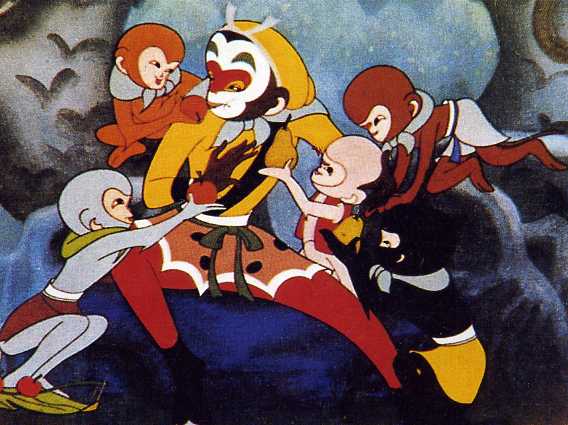Cartoons of Monkey King sketch strong cultural bond in East Asia

The Chinese animation film Havoc in Heaven, filmed by the Shanghai Animation Film Studio, used colors and designs from Peking Opera.
2016 marks the Year of the Monkey in the Chinese lunar calendar. The Monkey King, a famous literary character, has already become the symbol of the year and its cartoon images can be seen everywhere in China. A legendary monkey born in a magic stone, the Monkey King has enduring popularity in East Asia and has become a favorite of cartoonists.
The Monkey King is the protagonist of the Chinese epic The Journey to the West which is filled with Buddhist themes and mythological imagery. These visual elements provide rich creative resources for Chinese and Japanese cartoonists. Cartoons, including picture books, comics and animation, offer an imaginary and creative space for the Monkey King within the visual arts. Over the course of the Monkey King subculture evolution, Chinese and Japanese cartoonists contributed to creating a kaleidoscope of images of the iconic figure through mutual interaction, integration and conflict.
After the Ming and Qing block-printed edition of The Journey to the West spread eastward, many Japanese painters in the Edo period (1603-1867) created Ukiyo-e woodblock prints with themes from the book. Since the 1920s, Japanese cartoonists have attempted to adapt the story in cartoon form. During the same period, comics based on The Journey to the West came out in China.
In 1952, Japanese manga artist, cartoonist and animator Osamu Tezuka (1928-89) began to draw a series of comics Boku no Son Goku, which is based on the classic and published on a comic for seven years. Toei Company, a famous Japanese animation company, invited Tezuka to adapt Boku no Son Goku and filmed it on screen under the title Alakazam the Great. Released in 1960, Alakazam the Great mixed elements of action films, comedies and musical drama. It premiered prior to the Chinese animated film Havoc in Heaven, which was filmed by the Shanghai Animation Film Studio.
Havoc in Heaven finished production in the early 1960s, but the two volumes of the film were released for the first time in 1978, which became an unforgettable memory for Chinese audiences who are fans of the Monkey King. The appearance of the Monkey King in the film is derived from traditional Chinese opera facial makeup, and his costume is in red and yellow colors which hold special significance for Chinese audiences.
The image of the Monkey King in Chinese comics basically retains the characteristics of fine-lined pen portraits from Ming and Qing woodblock prints, which show a realistic style. Since the 1950s, many art publishing presses in Shanghai, Hebei Province and other places have published a complete set of comics of The Journey to the West, which have been reprinted in several editions and exerted a far-reaching influence on Chinese readers.
After the late 1980s, Chinese comics declined because of the lack of original creativity and external shocks from Japanese cartoons. But this drives Chinese comics to transform into a better form. In the Year of the Monkey, both Chinese and Japanese cartoonists will continue to create various images of the Monkey King to delight cartoon fans in East Asia.
Qin Gang is from the Beijing Center for Japanese Studies.
